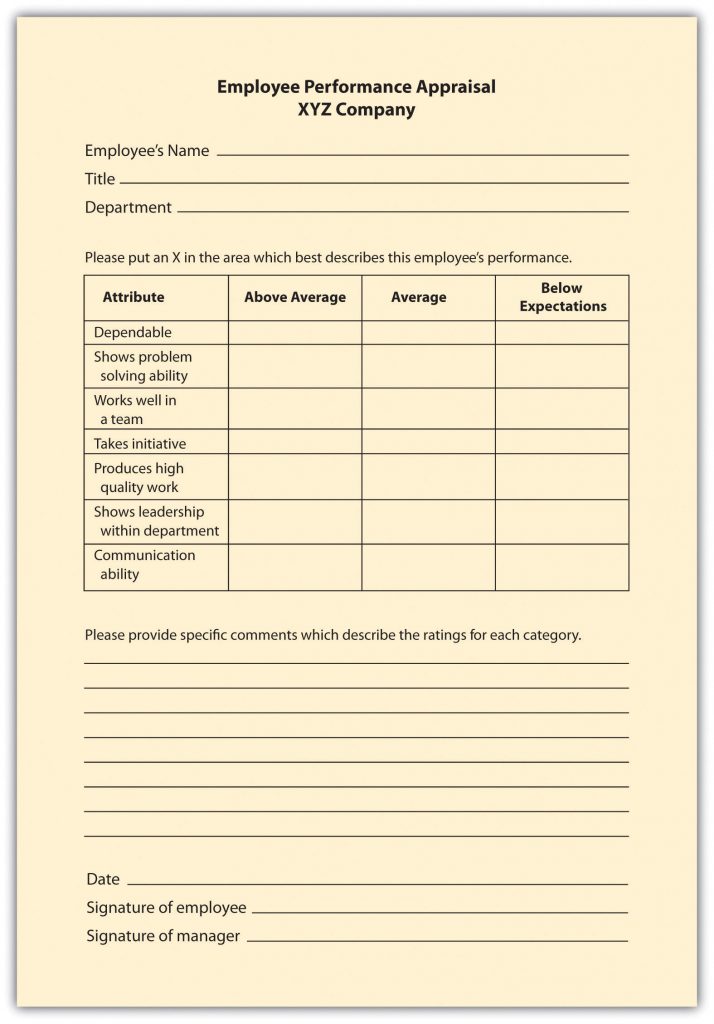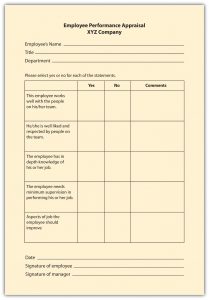12.4 Appraisal Methods
This section will discuss some of the main methods used to assess performance. However, before discussing these methods, we must discuss how they approach the assessment of individual performance. Some methods focus on the employee’s specific traits about the job. For these methods, the objective is to capture whether or not the employees possess the knowledge, skills, abilities and other characteristics (KSAO’s) required for the job. An example would be to assess whether a salesperson is outgoing or whether the accounts payable clerks are conscientious and pay attention to detail. Another way to approach performance assessment is to look at individual actions within a specific job. This focus on behaviour, for example, would measure whether the salesperson uses a specific protocol when approaching customers or whether the accounts payable clerk follows up on her phone calls. The focus is on ‘what employees do’ instead of ‘who the employee is’ (for the trait methods). Comparative methods compare one employee with other employees. Finally, results methods are focused on objective employee accomplishments. Note that many organizations will use these methods in combination.
Graphic Rating Scale
The graphic rating scale, a trait method, is perhaps the most popular choice for performance evaluations. This type of evaluation lists the traits required for the job and asks the source to rate the individual on each attribute, such as dependability and creativity. For example, the ratings can include a scale of 1–10; excellent, average, or poor; or exceeds, meets, or does not meet expectations.
| Poor | — | — | — | — | — | — | — | — | — | Exceptional |
| 0 | 1 | 2 | 3 | 4 | 5 | 6 | 7 | 8 | 9 | 10 |

Essay Appraisal
In an essay appraisal, the evaluator answers a series of questions about the employee’s performance in essay form. Depending on how the manager writes the essay, this can be a trait and/or a behavioural method. These statements may include strengths and weaknesses about the employee or statements about past performance. They can also have specific examples of past performance.

Checklist Scale
A checklist method for performance evaluations lessens subjectivity, although subjectivity will still be present in this rating system. With a checklist scale, a series of questions are being asked, and the manager simply responds yes or no to the questions, which can fall into either the behavioural or the trait method, or both. Another variation to this scale is a checkmark in the criteria the employee meets and a blank in the areas the employee does not meet.

Critical Incident Appraisals
While Critical Incident Appraisals are more time-consuming to develop, they can be effective because they provide specific examples of behaviour to anchor the ratings. With acritical incident appraisal, the manager records examples of the employee’s effective and ineffective behaviour during the time period between evaluations, which is in the behavioural category. When it is time for the employee to be reviewed, the manager will pull out this file and formally record the incidents that occurred over the time period. This method can work well if the manager has the proper training to record incidents (perhaps by keeping a weekly diary) in a fair manner. This approach can also work well when specific jobs vary greatly from week to week, unlike, for example, a factory worker who routinely performs the same weekly tasks.
Work Standards Approach
A work standards approach could be the more effective way of evaluating employees for certain specific jobs in which productivity is essential. With this results-focused approach, a minimum level is set and the employee’s performance evaluation is based on this level. This approach works best in long-term situations, in which a reasonable measure of performance can be over a certain period. For example, in an automotive assembly line, the focus is on how many cars are built in a specified period, and therefore, employee performance is measured this way. Since this approach is centred on production, it does not allow for rating of other factors, such as ability to work on a team or communication skills, which can be important parts of the job.
Ranking Method
In a ranking method system, employees in a particular department are ranked based on their performance. This system is a comparative method for performance evaluations. This method is stack ranking of employees based upon individual performance appraisal ratings (numeric or classification). A performance distribution chart is developed to show what percentage are rated as poor, marginal, meets, and exceeds with respect to performance.
“Appraisal Methods” in Human Resources Management – 2nd Ontario Edition by Elizabeth Cameron is licensed under a Creative Commons Attribution-NonCommercial-ShareAlike 4.0 International License, except where otherwise noted.

